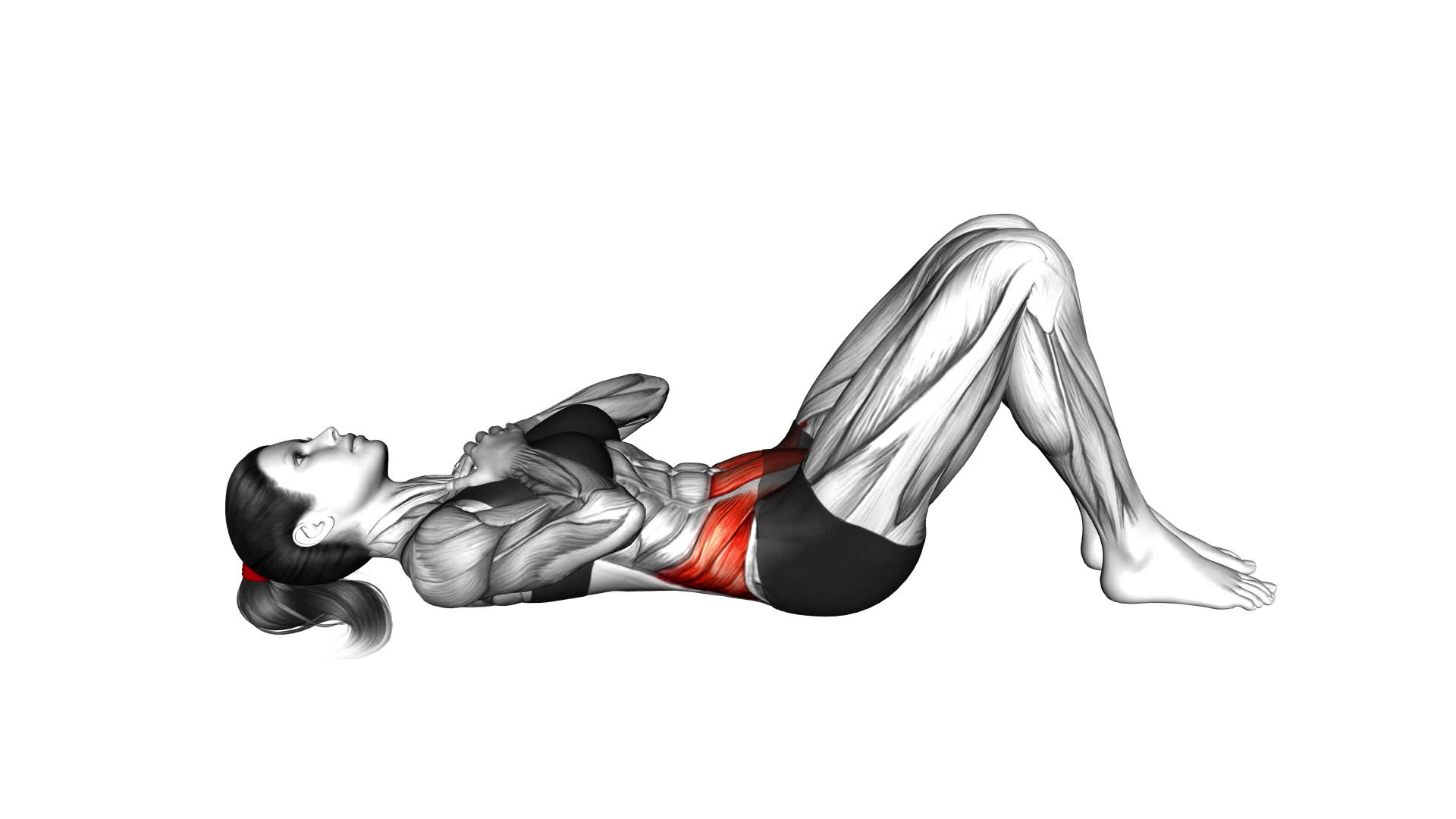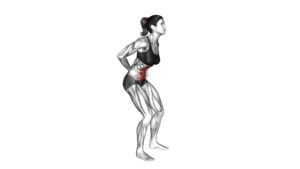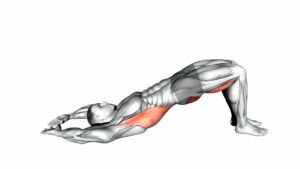Lying Pelvic Tilt (female) – Video Exercise Guide & Tips

Are you looking to improve your core strength and stability? Look no further than the lying pelvic tilt exercise.
Watch This Exercise Video
In this video exercise guide, we'll show you how to properly perform this exercise and provide helpful tips along the way.
Whether you're a beginner or looking for advanced variations, this exercise is for you.
Get ready to strengthen your core and achieve better posture with the lying pelvic tilt.
Let's get started!
Key Takeaways
- Lying Pelvic Tilt exercise strengthens muscles in the core, lower back, abdomen, and hips.
- Proper form and technique are crucial to maximize the benefits and avoid common mistakes.
- Pelvic Tilt benefits include improved core stability, enhanced pelvic floor function, and increased hip mobility.
- Equipment, modifications, and advanced variations can be used to increase the challenge and target specific muscle groups.
Benefits of Lying Pelvic Tilt Exercise
The lying pelvic tilt exercise provides numerous benefits for improving core strength and stability. By incorporating this exercise into your fitness routine, you can experience a range of advantages that will enhance your overall physical well-being. One of the primary benefits of the lying pelvic tilt exercise is its ability to strengthen the muscles in your core. This exercise specifically targets the muscles in your lower back, abdomen, and hips, which are essential for maintaining proper posture and stability. Additionally, the lying pelvic tilt exercise can help alleviate lower back pain and improve your flexibility.
To further enhance the benefits of the lying pelvic tilt exercise, there are several modifications and advanced variations that you can incorporate into your routine. Pelvic tilt modifications include using an exercise ball or resistance bands to add an extra challenge to the exercise. This can help engage more muscles in your core and increase the intensity of the workout. Advanced pelvic tilt variations, such as the single-leg pelvic tilt or the pelvic tilt with a leg extension, can further target specific muscles in your core and enhance your overall strength and stability.
Proper Form and Technique
Now let's talk about the important points to keep in mind when performing the lying pelvic tilt exercise.
Proper form and technique are crucial for maximizing the benefits and avoiding common mistakes.
Pelvic Tilt Benefits
To maximize the benefits of pelvic tilt exercises, ensure that you maintain proper form and technique throughout. This will help you to engage the correct muscles and avoid any unnecessary strain or injury. Here are four key benefits of performing pelvic tilts correctly:
- Improved core stability: Proper form and technique during pelvic tilts can strengthen your deep core muscles, including the transverse abdominis and pelvic floor muscles. This increased stability can help improve posture and reduce the risk of lower back pain.
- Enhanced pelvic floor function: By correctly performing pelvic tilts, you can strengthen and tone the muscles of the pelvic floor. This can be particularly beneficial for women postpartum or those with pelvic floor dysfunction.
- Increased hip mobility: Pelvic tilts can help to mobilize and stretch the hip flexors, improving hip mobility and reducing tightness in the hip area.
- Better body awareness: Performing pelvic tilts with proper form helps to improve your body awareness and proprioception. This can enhance your overall body alignment and movement patterns.
Common Form Mistakes
When performing a lying pelvic tilt exercise, it's important to be aware of common form mistakes to ensure proper form and technique. By avoiding these mistakes and correcting your form, you can maximize the effectiveness of the exercise and minimize the risk of injury.
One common mistake is arching your back too much, which can put excessive strain on your lower back. To correct this, focus on engaging your core muscles and keeping your spine in a neutral position throughout the movement.
Another mistake isn't fully activating your glutes and hamstrings, which reduces the effectiveness of the exercise. Make sure to squeeze your glutes and engage your hamstrings as you lift your pelvis off the floor.
Equipment Needed for Lying Pelvic Tilt
You'll need a yoga mat and a small towel for the lying pelvic tilt exercise. Here are four items that will enhance your workout and help you achieve proper form and effective modifications:
- Yoga Mat: A yoga mat provides cushioning and support for your body during the exercise. It also helps prevent slipping and adds stability.
- Small Towel: Placing a small towel under your lower back can provide additional support and comfort. It helps maintain the natural curve of your spine and prevents excessive pressure on the tailbone.
- Resistance Band: Adding a resistance band can increase the intensity of the exercise by challenging your muscles further. It helps to strengthen your core and hip muscles, promoting better pelvic alignment.
- Pilates Ball: Incorporating a pilates ball can add instability, engaging your core muscles even more. It requires extra effort to maintain balance, helping to improve stability and coordination.
Modifications for Beginners
As a beginner, it's important to start with gentle progressions when performing the lying pelvic tilt exercise. This means gradually increasing the intensity and range of motion as you become more comfortable and confident.
Additionally, adapting the exercises to suit your fitness level is crucial, such as using modifications or props to make the movements more accessible and manageable.
Gentle Progressions for Beginners
Start with a few simple modifications to gradually ease into the lying pelvic tilt exercise. Here are four gentle progressions and beginner modifications to help you get started:
- Begin by lying on your back with your knees bent and feet flat on the floor. This will provide a stable base for the exercise.
- If you find it difficult to engage your core muscles, try placing a small pillow or rolled-up towel under your lower back. This will provide extra support and help you maintain proper form.
- As you become more comfortable with the exercise, you can progress by extending one leg at a time while maintaining the pelvic tilt. This will challenge your core stability and increase the difficulty of the exercise.
- To further progress, you can try lifting your heels off the ground while maintaining the pelvic tilt. This will engage your glutes and hamstrings, providing a more challenging workout for your lower body.
Remember to listen to your body and only progress to the next modification when you feel ready.
Adapting Exercises for Beginners
To modify exercises for beginners, begin by making small adjustments to ensure proper form and support. Adapting exercises is essential for beginners to build a strong foundation and prevent injury. Start by reducing the range of motion or intensity of the exercise.
For example, if a squat is too challenging, try doing a partial squat or using a chair for support. Another modification is to decrease the number of repetitions or sets. This allows beginners to gradually build strength and endurance without overwhelming their bodies.
Additionally, using props such as resistance bands or stability balls can provide extra assistance and stability. Remember, it's important to listen to your body and progress at your own pace.
With these beginner modifications, you can safely and effectively improve your fitness level. Now, let's explore advanced variations and progressions to continue challenging yourself.
Advanced Variations and Progressions
Exploring more challenging variations and progressions can enhance your lying pelvic tilt exercise routine. Here are four advanced modifications and techniques to take your pelvic tilt to the next level:
- Single Leg Pelvic Tilt: Lift one leg off the ground while performing the pelvic tilt. This variation increases the demand on your core muscles and improves stability.
- Swiss Ball Pelvic Tilt: Place a Swiss ball between your feet and squeeze it as you perform the pelvic tilt. This adds an element of instability, engaging more muscles and improving balance.
- Weighted Pelvic Tilt: Hold a dumbbell or medicine ball on your pelvis while performing the tilt. The added resistance challenges your muscles further and helps increase strength and stability.
- Bridge with Pelvic Tilt: Start in a bridge position with your hips lifted off the ground. While maintaining the bridge, perform the pelvic tilt. This exercise combines the benefits of the bridge and pelvic tilt, targeting your glutes, hamstrings, and core muscles.
Remember to always maintain proper form and technique during these advanced variations. Start with lighter weights or fewer repetitions and gradually increase the intensity as your strength improves.
Incorporating these advanced modifications and techniques into your lying pelvic tilt routine will challenge your muscles in new ways and help you achieve greater fitness gains.
Tips for Maximizing Results
To maximize your results, consistently incorporate these tips into your lying pelvic tilt routine.
First and foremost, focus on maximizing the intensity of your workouts. This can be achieved by increasing the number of repetitions or sets, adding resistance, or reducing rest time between exercises. By pushing yourself to work harder during each session, you'll stimulate greater muscle activation and promote better overall strength and toning.
Another key tip for maximizing results is to prioritize post-workout recovery. After completing your lying pelvic tilt routine, take the time to properly cool down and stretch your muscles. This will help prevent muscle soreness and stiffness, and promote faster recovery. Additionally, ensure you're giving your body enough time to rest and recover between sessions. Overtraining can lead to decreased performance and increased risk of injury, so make sure to listen to your body and take rest days when needed.
Lastly, remember to stay consistent with your routine. Consistency is key when it comes to achieving long-lasting results. Aim to perform your lying pelvic tilt exercises at least three times a week, and make it a habit to incorporate them into your regular exercise routine.
Frequently Asked Questions
Can Lying Pelvic Tilt Exercises Help With Postpartum Recovery?
Lying pelvic tilt exercises can be beneficial for postpartum recovery. By engaging the pelvic floor muscles and promoting core stability, these exercises can help strengthen the pelvic floor and alleviate symptoms of diastasis recti.
Incorporating lying pelvic tilts into your exercise routine can assist in restoring the strength and function of your abdominal muscles after childbirth. It's important to consult with a healthcare professional or a qualified fitness instructor to ensure proper form and technique.
Is It Safe to Perform Lying Pelvic Tilt Exercises During Pregnancy?
During pregnancy, it's essential to take precautions when exercising. It's best to consult with your healthcare provider before performing lying pelvic tilt exercises during pregnancy. They can advise you on safe modifications or alternative exercises that will help maintain pelvic stability without putting unnecessary strain on your body.
While lying pelvic tilt exercises can be beneficial for postpartum recovery, it's important to prioritize your safety and well-being during this special time.
Can Lying Pelvic Tilt Exercises Help Alleviate Lower Back Pain?
Lying pelvic tilt exercises can indeed help alleviate lower back pain. By engaging your core muscles and gently tilting your pelvis, you can strengthen your abdominal muscles and improve your posture.
This technique is beneficial for both men and women, as it targets the muscles that support your lower back. Incorporating lying pelvic tilt exercises into your routine can provide relief from discomfort and promote a healthier spine.
Are There Any Specific Breathing Techniques to Follow During Lying Pelvic Tilt Exercises?
During lying pelvic tilt exercises, it's important to focus on your breathing technique to enhance the effectiveness of the exercise and engage your pelvic floor muscles.
By coordinating your breath with the movement, you can strengthen your pelvic floor and improve stability in your lower back.
Proper breathing involves inhaling deeply through your nose and exhaling fully through your mouth, activating your diaphragm and engaging your core.
This technique can maximize the benefits of the lying pelvic tilt exercise.
How Often Should Lying Pelvic Tilt Exercises Be Performed for Optimal Results?
To achieve optimal results, it's important to perform lying pelvic tilt exercises regularly. By incorporating this exercise into your routine, you can reap the benefits of improved core strength, stability, and posture.
Remember to maintain proper form and technique throughout the exercise, focusing on engaging your pelvic muscles and avoiding any excessive arching or rounding of the back.
Consistency is key, so aim to incorporate lying pelvic tilt exercises into your workout routine several times a week.
Conclusion
In conclusion, the lying pelvic tilt exercise is a beneficial exercise for women that targets the pelvic muscles and helps improve core stability.
By maintaining proper form and technique, using the necessary equipment, and following modifications for beginners or advanced variations, individuals can maximize their results.
Incorporating this exercise into a regular workout routine can contribute to better posture, increased strength, and improved overall fitness.

Author
Years ago, the spark of my life’s passion ignited in my mind the moment I stepped into the local gym for the first time. The inaugural bead of perspiration, the initial endeavor, the very first surge of endorphins, and a sense of pride that washed over me post-workout marked the beginning of my deep-seated interest in strength sports, fitness, and sports nutrition. This very curiosity blossomed rapidly into a profound fascination, propelling me to earn a Master’s degree in Physical Education from the Academy of Physical Education in Krakow, followed by a Sports Manager diploma from the Jagiellonian University. My journey of growth led me to gain more specialized qualifications, such as being a certified personal trainer with a focus on sports dietetics, a lifeguard, and an instructor for wellness and corrective gymnastics. Theoretical knowledge paired seamlessly with practical experience, reinforcing my belief that the transformation of individuals under my guidance was also a reflection of my personal growth. This belief holds true even today. Each day, I strive to push the boundaries and explore new realms. These realms gently elevate me to greater heights. The unique combination of passion for my field and the continuous quest for growth fuels my drive to break new ground.



